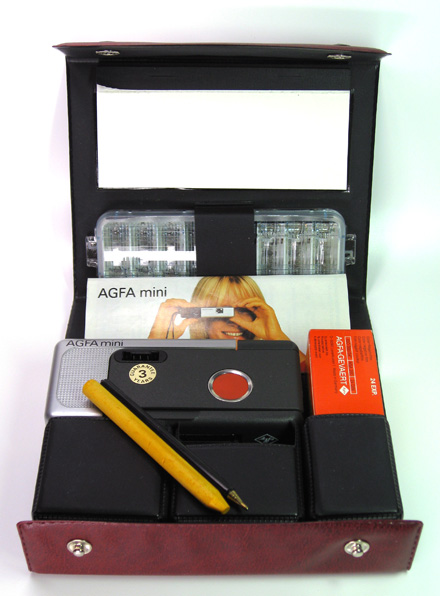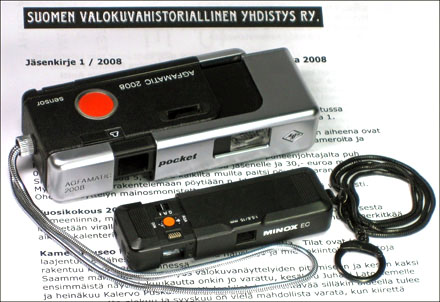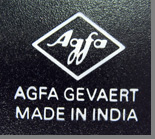Agfa Kamerawerk AG, Munchen, Germany

Agfamatic Pocket
During the Seventies the highly advanced film technology made it possible to introduce cameras with smaller negative size. Of course there has been some "detective" cameras before that. Famous Minox Cameras as an example. They used mostly b/w film which was sharp (fine grained) enough to get acceptable results.
|

Agfa was one the first manufacturers of cameras to follow Kodak after the launching of the 110 film. And the series of Agfamatic cameras which used this film format was introduced in 1970. Like its larger126 brother, the 110 formatwas developed around aplastic drop-in-to-load filmcartridge. As a result, all 110cameras are designed to and its size and shape impose certain limitations on what a camera designer can do and still produce what we've come to call a "pocket" camera. The cartridge is designed with a take-up core that's larger than the supply core and fitted with a plastic driving gear on the bottom for film transport. As the cartridge can only be inserted into the film chamber in one way, this particular design makes it impossible to load a 110 camera incorrectly. |
The 110 film, the successor of the 126 film Instamatic, despite a lot of hope is now completely on the decline. The APS film has replaced it and as you well know the future of APS seems not to be especially glorious. These three models have only slightly different features. Agfamatic Pocket 1008 (Below in a picture) has no metal covering like the other two. Model 2008 uses different type of flash "bulbs". I think that this modification is made to get rid of the fairly complicated flash cube revolving mechanism. Each time when you push and pull for the film advance/shutter cocking the flash cube is also turning 90 degrees to be ready for the next shot. It is convenient but the necessary mechanism is not easy to arrange inside the tiny body. Model 2008 uses different type of flash "bulbs". I think that this modification is made to get rid of the fairly complicated flash cube revolving mechanism. Each time when you push and pull for the film advance/shutter cocking the flash cube is also turning 90 degrees to be ready for the next shot. It is convenient but the necessary mechanism is not easy to arrange inside the tiny body. |

Agfa introduced its red "sensor" release button in 1968. It is a round membrane made of red foil and framed with a metal ring. Depending on the camera type, either a mechanical or an electromechanical shutter release button was hidden under the flexible membrane.
This good and convenient touchpad-like shutter button was afterwards used on most of the Agfa models and became a familiar feature.
"While the 110 camera was an ideal instrument to record family activities and vacations, its virtues made it unexcelled for other photographic uses.
The 110's small size makes it a perfectly unobtrusive device for candid photography, as well as criminal, investigative and surveillance work; with its automated exposure, there's no manipulation of the camera necessary to disturb your subject—just compose and shoot". |
|
Agfa mini (1981)
Agfa mini business gift set by the PFERD company
 |
 |
Color Optar 11/32The Agfa mini uses Flipflash with 8 or 10 flash bulbs in a long rectangular box fired in turn. (See the business gift set on the left.) |

|
"Minox welcomes the Pocket Instamatic to the world of miniature photography" |
Major specifications, model 2000
- Lens: fixed-focus Color-Agnar 1:9,5/26 mm (3 elements). Focus range from 1.2 meters to infinity.
- Shutter: Mechanical shutter with switch able speeds of 1/100 sec. and 1/50 sec. The shutter is mounted externally, in front of the lens. The speeds are marked by symbols - Sun for 1/00 sec., Cloud for 1/50.
- Dimensions:
- Closed: 113 (L) x 53 (W) x 27 (H) mm / 4.4 (L) x 2.1 (W) x 1.1 (H) inches
- Open: 133 (L) x 53 (W) x 27 (H) mm / 5.2 (L) x 2.1 (W) x 1.1 (H) inches
- Weight: 200g
- Features: Flash-cube socket - inserting a flash-cube switches the shutter speed to 1/50 sec.
|
 In the early 1980s Agfa produced its last cameras. The new models of the Selectronic series were manufactured by Chinon. Agfa gave up camera production in 1983. All later Agfa cameras were OEM products. In the early 1980s Agfa produced its last cameras. The new models of the Selectronic series were manufactured by Chinon. Agfa gave up camera production in 1983. All later Agfa cameras were OEM products.
Negative/Slide size: All 110 cameras produce 13x17mm negatives on specially perforated 16mm film.
|
 |
|
©2008
Reijo Lauro